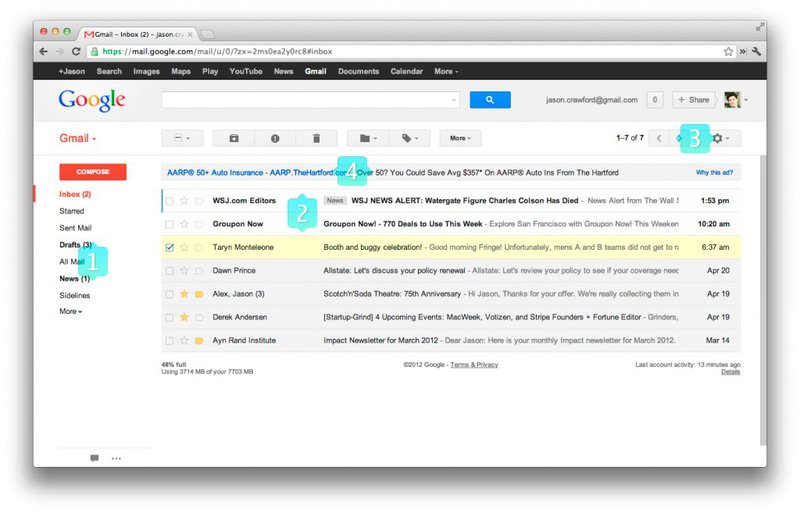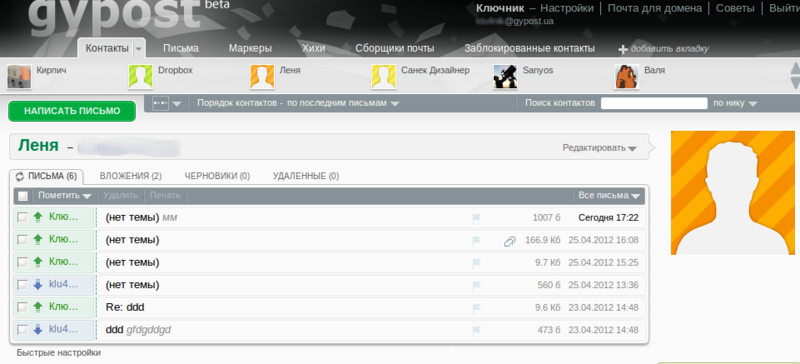An overview of the functionality of web-based e-mail
 Long ago, urgent messages were carried by pigeons. Their life was, as a rule, short and dangerous. Birds of prey, difficult weather conditions and low-flying UFOs greatly reduced the chances of successful delivery of small letters. In general, the hard life was the birds. To the great benefit of the birds in the XIX century, their work began to perform the telegraph, and at the end of the XXth, emerging e-mail.
Long ago, urgent messages were carried by pigeons. Their life was, as a rule, short and dangerous. Birds of prey, difficult weather conditions and low-flying UFOs greatly reduced the chances of successful delivery of small letters. In general, the hard life was the birds. To the great benefit of the birds in the XIX century, their work began to perform the telegraph, and at the end of the XXth, emerging e-mail.In the XXI century, instead of cute birds, mail is spread by thousands of servers. And the way that a brief note could overcome for months now takes no more than a few minutes.
E-mail has firmly taken place in our lives. The popularity of social networks, chat rooms and other instant messaging systems has not influenced its popularity too much. Mail was and remains the main working tool that allows you to share information with colleagues, transfer data, and use it in the personal life of half of the Internet population. As in other industries, IT mail is increasingly going to the clouds, somewhat changing and transforming. In this article I would like to elaborate on the approach of working with correspondence through a web interface in various mail services *.
Gmail
The creation of the giant implements the traditional approach to user access to their correspondence in the classic style to date. This approach is perfectly familiar to us from desktop email clients and is used by companies such as: Yandex, Mail.ru, Hotmail, and many others. This approach is characterized by the division of user space on the monitor screen into four main elements:
')
1. Folders groups of letters on the characteristics. These are familiar Inbox, Sent, Trash, and user folders. Here, often, the button "Write a letter."
2. The list of letters that contains the selected folder;
3. Box setting items and statistical information;
4. Advertising space;
Classic performance - on the left of the folder, in the center of the list of letters, on top - the settings.

But despite the apparent simplicity, the creators of gmail implemented a sufficient number of unique functions, apart from which was the function of chains of letters, which at that time were completely ignored by all web interfaces.
For those who are a little unaware: Chains of letters are correspondence messages grouped by subject located in the header of the letter.
In Gmail, conversations are displayed as a single thread of messages on a topic. Having opened the last letter from the thread in the inbox, we get access to the entire history of correspondence on this topic.
This would be a great solution if not for the
By the way, the opinion that the chain of letters is an invention of Google is quite common, but this is not quite so. A similar sorting method was used in Outlook 2003 and in earlier versions of Thunderbird and The-Bat. In Outlook, starting from version 2003, the function of chains is one of the sorting methods and is activated from the View / Arrange by / Conversation menu (only incoming are sorted).
In addition to Gmail, Yandex Mail uses chaining, but in it, this function is rather optional and does not bring any real benefit. Chains from Yandex group letters only in the general message feed, and if you open a letter from the chain, then only one letter will be available to you, and you will not be able to view the entire chain. The same drawback applies to most web-based email systems, such as: Hotmail, I.UA, Mail.ru, Rambler.ru, Ukr.net and Yahoo.com.
Mail.ua and Zoho mail stand out against the background of the rest, their design is more reminiscent of desktop mail clients. At the same time, they use a completely traditional approach to working with the flow of letters.
We should also mention the service gYpost.ua, which in my opinion uses the most interesting approach to the organization of letters. Users are available at any time contact tape, on which information appears on the number of letters from a particular contact. In the first place in the tape is always the contact, the letter of which came last.
When you click on a contact, all correspondence with him in a chronological order falls out, which is quite convenient.

gYpost is now in Beta status, but as far as I understand, the functionality works and continues to evolve.
Attachments
In working with a large number of letters, I often encounter difficulties in finding attachments to letters. Indeed, when you are sent about a dozen contracts and other documents during the day, it becomes quite difficult to work and here you either need to get into the habit of copying and sorting everything into folders, or wasting precious time searching for the right file. A similar approach to solving this issue is using Yandex mail, gYpost and Mail.ru. In Mail.ru, this is implemented as a separate tab in which letters from all contacts are displayed. In Yandex Mail, all of this is implemented very similarly on the basis of Yandex Disk, which has a separate attachment tab.
Note: Given that Yandex Disk is a cloud storage, I expected from it that the attachment folder will also be synchronized, to my surprise, this does not happen. It can be seen Yandex UFO is not fully thought through this moment or guided by other considerations.
Mail gYpost and here showed itself somewhat original, offering storage of all attachments separately for each contact.
Unfortunately, Google, unlike its Russian competitor, did not even build in Google Drive even limited support for working with attachments. However, there is a small hack that allows you to save important attachments from Gmail directly to Drive.
Really big files.
Sometimes there is a task to send a fairly large file (for example, 1 GB) via mail. Two years ago, I would probably advise you to upload it to some kind of file hosting or drop it into DropBox. Now it all depends on your needs. If you need to control the lifetime of the file yourself, then the only choice for you is to use cloud services or your own dedicated server. If the speed of sending is more important for you, then you should pay attention to the function of sending large files implemented in some mail services.
The fact is that in order to send a file via file hosting or cloud storage, you need to switch to a separate tab or another program and take all the actions there to upload files to the network (moving a file, copying a public link and inserting it into a letter, etc.) . At the same time, the built-in function for sending large files will automatically download and insert a link to the file without leaving the letter creation dialog box.
The table shows data on the solutions used in the mail services considered:
| Gmail | gYpost | Hotmail | I.UA | MAIL.RU | |
| Volume | 10 GB | 5 GB | 5 GB | 1 GB (may increase volume) | 10 GB (may increase volume) |
| Maximum investment size in the letter | 25 MB | 25 MB | 25 MB | 20 MB | 20 MB |
| MAIL.UA | Rambler Mail | Ukr.net | Yahoo | Yandex-mail | |
| Volume | No data | 2 GB | 2 GB | No data | 10 GB (unlimited increase in volume) |
| Maximum investment size in the letter | 25 MB | 30 MB | 18 MB | 25 MB | 30 MB |
| Gmail | gYpost | Hotmail | I.UA | MAIL.RU | |
| Sending large files | Yes (via Google Drive) | Yes | Yes (via Skydrive) | Yes | Yes |
| Maximum file size | 5 GB | 2 GB | 100 MB through web, 2 GB through desktop application | 2 GB | 1 GB |
| Recipients | User of any mail service | User of any mail service | User of any mail service | Mail service user i.ua | User of any mail service |
| Storage type | Permanent | Temporary for 7 days | Permanent | Temporary for 14 days | Temporary for 30 days (there is a charge for an increase in the storage period) |
| Place for storage | Up to 5 GB for all time (Google Drive capacity) | Up to 2 GB per day | Up to 7 GB | Up to 8 GB | Up to 10 GB |
| MAIL.UA | Rambler Mail | Ukr.net | Yahoo | Yandex-mail | |
| Sending large files | Not | Not | Yes | Yes | Yes (via Yandex disk) |
| Maximum file size | 1.5 GB | 100 MB | 10GB | ||
| Recipients | User mail service Ukr.net | No data | User of any mail service | ||
| Storage type | Temporary for 7 days | No data | Permanent | ||
| Place for storage | Up to 10 GB | No data | Up to 10 GB for all time (Yandex Disk Size) |
Work with text
If you send letters without any formatting at all, then you do not need to read this paragraph, if you still sometimes at least make the text bold, then you should pay attention to the lines below.
In the absolute majority of modern postal systems, advanced editing mode is implemented. It includes familiar elements such as customizing the font and its size, background and text colors, creating bulleted or numbered lists, inserting and managing, inserting hyperlinks and images, and managing text alignment.
In addition to this functionality, some systems support additional functions. For example, Gmail (the default feature is turned off and turned on in Labs) and gYpost allow you to control the size of the inserted image, with gYpost providing maximum control, giving you the opportunity to adjust such moments as resolution, indents and image alignment.
Of the additional bonuses, I would also like to note the use of letter templates. This functionality is implemented in gYpost, Mail.ua and Yahoo. Yandex mail has postcards instead of templates.
| Gmail | gYpost | Hotmail | I.UA | MAIL.RU | |
| Advanced email editing mode | Yes, no patterns | Yes, with letter templates | Yes | Yes | Yes |
| Inserting images in the text of the letter | Yes, with a change permission after connect function editing in the laboratory. | Yes with extended management. Insert on the link settings indentation align and size. | Yes (paste only from another place) | Yes (paste only from another place) | Yes (paste only from another place) |
| Pictures in captions | Yes (from external link, if you copy letter signature from outlook then you can attach picture in the signature code) | Yes (from external link) | Yes (from external link) | Not | Not |
| MAIL.UA | Rambler Mail | Ukr.net | Yahoo | Yandex-mail | |
| Advanced email editing mode | Yes, with letter templates | Yes | Yes | Yes, with letter templates | Yes, with postcards |
| Inserting images in the text of the letter | Yes insert from file and link | Yes (paste only from another place) | Yes (paste only from another place) | Yes (paste only from another place) | Yes (paste only from another place) |
| Pictures in captions | Not | Not | Not | Yes (from external link) | Not |
Instead of conclusions
Today, email giants are not in too much of a hurry to develop their services. If something changes, and so is the appearance, the functional is developing poorly.
It is the sluggishness of the development of giants that gives a big enough chance to young companies to implement the new functionality first.
Among the newbies, I would like to point out the gYpost and Mail.ua projects as using interesting and functional solutions for some tasks.
Among the giants, from my point of view, Gmail and Yandex Mail are currently leading in terms of mail functionality.
PS
This post covers only the top functionality of mail systems, but I plan to continue to analyze this topic and share my observations with you.
Pps
I think that if pigeon mail will once again become popular, it will look something like this.

Notes:
* Mail services are selected by functionality and popularity in the CIS. Sorting in enumerations alphabetically.
Source: https://habr.com/ru/post/103449/
All Articles